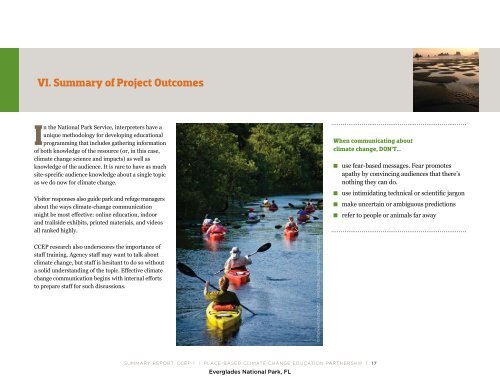Place-based Climate Change Education Partnership Report.pdf
Place-based Climate Change Education Partnership Report.pdf
Place-based Climate Change Education Partnership Report.pdf
Create successful ePaper yourself
Turn your PDF publications into a flip-book with our unique Google optimized e-Paper software.
VI. Summary of Project Outcomes<br />
In the National Park Service, interpreters have a<br />
unique methodology for developing educational<br />
programming that includes gathering information<br />
of both knowledge of the resource (or, in this case,<br />
climate change science and impacts) as well as<br />
knowledge of the audience. It is rare to have as much<br />
site-specific audience knowledge about a single topic<br />
as we do now for climate change.<br />
Visitor responses also guide park and refuge managers<br />
about the ways climate-change communication<br />
might be most effective: online education, indoor<br />
and trailside exhibits, printed materials, and videos<br />
all ranked highly.<br />
CCEP research also underscores the importance of<br />
staff training. Agency staff may want to talk about<br />
climate change, but staff is hesitant to do so without<br />
a solid understanding of the topic. Effective climate<br />
change communication begins with internal efforts<br />
to prepare staff for such discussions.<br />
<br />
When communicating about<br />
climate change, DON’T…<br />
use fear-<strong>based</strong> messages. Fear promotes<br />
apathy by convincing audiences that there’s<br />
nothing they can do.<br />
use intimidating technical or scientific jargon<br />
make uncertain or ambiguous predictions<br />
refer to people or animals far away











